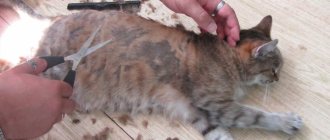Many owners do not think about how to train a cat to teach it any commands or tricks, believing that it is too independent an animal. However, the wards of the Kuklachev Theater prove that the intellectual abilities of cats are very strong, and even these independent pets can be taught a lot.
Today we will talk about methods of training domestic cats, talk about the simplest and most basic commands that a mustachioed pet can learn, and also share the nuances and rules of competent interaction with an animal so that training brings pleasure to both the cat and its owner.
How to train a cat to succeed?
Cats' ability to learn
Cats have a developed emotional sphere and a finely organized psyche. Thanks to this, they quickly become attached to all members of the owner’s family, but unlike dogs, they do not recognize the unconditional authority of humans. Therefore, cat training should be based on the animals receiving positive emotions and positive experiences, and not on the owner’s desire to take a leadership position and suppressing the pet.
The cat brain is structured similarly to the human brain. It has numerous neural connections, contains white and gray matter, and includes the parietal, temporal, and occipital lobes. When neurons in which information is stored are activated, animals remember certain events and objects.
Every trainer who wants to teach a cat to follow commands must know an important feature of the pet’s memory. For the animal, only the necessary information matters (the location of the tray, the rustling of a bag of food or the sound of the refrigerator door opening).
The cat will not remember the smell and appearance of a person who once visited the house and did not affect her in any way. But the pet will remember the visitor who caused pain for a very long time.
On a note. Multiple experiments involving cats have shown that their short-term memory is 12-16 hours. And the long-term one is even more developed.
Despite the dissimilarity of the speech apparatus, cats understand people very well. True, they perceive not the words themselves, but the emotional message embedded in them, intonation and sound wavelength. It has been proven that cats understand foreign speech perfectly if you communicate with them in a foreign language for two weeks.
Animals remember commands in the same way. And they do it faster than dogs. If the latter need an average of up to seven repetitions, then cats need only three. Therefore, they are easier to train than the average dog.
How to train a smart but wayward pet
You need to train kittens at home without coercion, otherwise you should not expect a positive result. Cats are very cunning creatures, with excellent memory, so if they do not want to exercise, then you should refuse training and move the training to another time or day.
Training a pet will not bring the expected result if the animal is not friendly and is wary of the person handling it . Even your favorite treat will not help correct the situation. The trainer, in turn, must remain calm, be reasonable, and sincerely love the pet. Only with such a prioritization will the cat follow commands.
At the end of each training session, you need to encourage and praise your furry pet. All trained cats love to be treated kindly, praised, and petted.
© shutterstock
Important Points About Cat Training
Kittens aged 2-7 months are considered most susceptible to training. If during this period the kids did not have time to gain some experience (external influences, communication with other animals and people), then later they will painfully perceive contacts with these “unknowns”. Of course, over time, adult animals will get used to the company of dogs or people, but this will take them much more time. This also applies to training - it is better to start training a kitten from the first months.
On a note. It has been proven that memory, sensitivity to training and the ability to make decisions develop in cats up to 2-3 years of age. As animals age, their brain functions decline. And after 7-8 years, pets perceive and remember new data worse, and also cope poorly with the volume of already known information.
Training cats at home is a long process. It is recommended to train animals several times a day for 5-10 minutes. It is better if the cat is trained by the one to whom she is more attached. To ensure that learning does not cause problems, you need to establish a trusting relationship with your four-legged student.
To do this, it is recommended to communicate and play with him more often. And in order not to undermine the animal’s trust, during the training process you should not shout at him or raise your hand.
Basics of education
The optimal age to start training, as we have already said, is six months. Since it is at this time that it is easier for the pet to master commands. The basics of education, along with the breed, play a fundamental role in training. Strict adherence to behavioral norms and sincere relationships between owner and pet are also a priority. It is advisable to begin preparations by accustoming the kitten to the rules established in the home.
The most important rules for starting successful training:
- It is necessary to buy the pet its own toys, otherwise for active entertainment the kitten will play with the things of the owner and his family.
- For sleep and rest, a young cat needs to have its own place. She should not play or doze on the master's beds and sofas.
- Just like a child, you should never yell at kittens or, especially, hit them. A stern and slightly raised voice will be enough for them to understand that they are being punished. Animals are good at distinguishing human intonation and remembering what they are not allowed to do.
- From the first months, the kitten must know the location of its plate. You cannot throw food from the table, otherwise he will jump on it and steal food.
- The cat must know that the litter tray is in the same place and needs to go only there. The first time he needs to be placed in the tray and not allowed to leave for 2-3 minutes.
- The psychology of communication is very important. You need to establish a trusting relationship with your domestic cat so that training does not cause problems in the future. It is worth paying more attention to the kittens, playing with them, stroking them and trying to reward them for following orders and good behavior.
Which cat breeds are best trained?
Although all cats are endowed with high intelligence and good memory, certain varieties have special tendencies for training. It is easier and simpler to train representatives of the following breeds:
- Scottish lop-eared. An active and sociable cat easily makes contact with people and lends itself well to training. She is able to retain more than 10 commands in memory and easily learns to perform various tricks.
- Thai. An active and lively cat that retains an interest in life until old age. She is easy to train and easily picks up different timbres and intonations of the human voice.
- Cornish Rex. A curious cat with a gentle and loyal disposition. He is ready to interact closely with people and is easy to train.
- Turkish van. A brave and emotional cat with a flexible psyche and high adaptive abilities. He is highly trainable and can master many tricks.
- Abyssinian. An active and intelligent cat, prone to self-learning. She loves logic games and instantly understands how to turn lights on/off or open doors.
- Burmanskaya. A fearless and sociable cat that loves to spend time in the company of its owners. She is very trainable and enjoys training.
- Canadian Sphynx. An intelligent and social cat with a gentle character. He tries to please his owners and easily remembers a large number of words and phrases.
- Bengal. A playful, flexible and active cat with developed intelligence and a friendly disposition. She easily makes contact with people and is very trainable.
Scottish fold cat
Thai cat
Cornish Rex
Turkish van
Abyssinian cat
Bengal cat
Training equipment
The cat training kit must be prepared before training. First of all, it depends on what command or trick the owner is going to teach the pet.
An important lesson: All objects are familiar to the cat, otherwise, instead of studying, he will sniff them.
Typically training equipment is:
- Small hoop
- Small balls
- Sticks with a toy at the end
- Threads
- Pointer with laser
- Chairs
- Container with goodies
You can buy toys and training items or make your own. It is better to store them in one place. The cat must have them. Otherwise, she will play with inappropriate things, sometimes even causing damage to them.
Preparing for training
It is recommended to train a kitten on any flat surface that is convenient for both the owner and the pet. This could be a carpeted floor or a grassy lawn in the yard. Before you train a cat, you need to make sure that you have all the required equipment at hand.
To learn simple commands, you only need a treat, which can be hard cheese or meat. Before training a cat, treats are cut into small pieces of 3-4 mm. If you give your pet large slices, he will quickly become full and lose interest in activities.
On a note. Dry food should not be used as a treat for training a cat. The animal will begin to chew the pellets and will be distracted from training.
To learn tricks and complex commands for cats, you need to prepare special furniture and appropriate equipment. Depending on the training goals, the trainer may need to:
- laser pointer;
- hoop with a diameter of 35 cm;
- round tables or chairs;
- small balls, tennis balls or balls of thread.
It is better to train a cat in the daytime or evening, 3-4 hours after feeding. A well-fed animal will probably want to sleep, but a hungry animal will refuse to work.
Important! You cannot train a cat after vaccination or during illness.
What you need to know when starting training
The cat will perform the action that will benefit it. Hence the first rule of training is to train your pet before eating. On an empty stomach, the kitten will quickly understand what needs to be done to get the coveted treat, because for every correctly performed action, a piece of his favorite food awaits him.
Use your pet's favorite food during training
Classes should not be long; five to seven minutes will be enough. If the cat gets bored, she will simply leave.
It’s a big mistake when training when a cat trainer starts raising his voice or using physical force on the cat. In this case, the pet will harbor a grudge and will not fulfill your requests. Is it possible to teach commands to a disgruntled cat? Of course not! Encouragement and kind attitude are the only motivators when training.
If your cat is sick, it is better to postpone training until complete recovery.
As a rule, among all family members, the cat chooses its owner. Only this person can train a pet and achieve results.
Classes should be taught by a beloved owner
Learn only one trick at a time. It is advisable to repeat it on the same day to consolidate it, for example, in the evening. Repetition is an inferior activity. It will be enough if the cat follows the command once or twice. If it doesn't work, you shouldn't continue.
Do your workouts in a quiet place where there are no distractions. And, of course, this place should not be new for the pet. The room where the cat spends most of its time is ideal.
Simple commands for cats
First you need to teach the cat commands that are easy to remember and do not require any stress from the pet.
To me
This is the simplest command you can teach a cat. Having chosen a moment when the pet is at a distance but sees the owner, they call him by name and, after showing him a treat, say “Come to me!” The cat that runs up is treated to a tasty treat and praised.
Sit, lie, stand
Training a cat to follow these commands is not difficult even for novice trainers. A treat is brought to the animal’s nose, lightly pressed on the croup, and when the pet begins to sit up, they say “Sit!”
Using a similar scheme, the cat is taught to follow the commands “Lie down!” and “Stop!” The easiest way to learn them is from a sitting position. To make the cat stand up, it is lifted under the stomach, showing a treat and pronouncing the appropriate command. To put your pet down, the treat is lowered below his nose and lightly pressed on the withers.
Give me your paw
You need to teach your cat this command while she is sitting next to you. She is allowed to sniff the hand in which the treat is clamped. When the cat tries to get the treat, its paw is pressed against your palm, saying “Give me your paw!”
On a note. If a cat tries to get food from a clasped palm with its teeth, it is taken by the paw to show what is required of it.
Gopher or bunny
You need to teach your cat this command while she is sitting. A treat is brought to her face and the piece is lifted so that the pet reaches for it. When the cat stands up on its hind legs, they give it the command “Bunny” or “Gopher” and give it a treat.
Jumping through a hoop
A hoop of the appropriate diameter is placed close to the ground and the cat is lured to it with a treat, forcing it to go through the hoop. At the moment when she jumps over an obstacle, the command “Up!” is pronounced. The distance between the floor and the hoop is increased gradually so as not to frighten the animal.
How to teach a cat to give paw
“Give me your paw” is a simple command, every tailed animal can learn it. It looks cute and impressive. Teaching a cat to give paw is easy. You need to approach a sitting animal, put its paw in your hands and say, “Give me your paw.” When the ritual is over, you need to reward the kitten for a successfully completed command by treating it with a treat.
A reflex should be formed in the experimental subject’s brain, which should provoke the kitten to give its paw, based on pleasant memories.
If the cat independently reaches for a treat lying in the palm of your hand, then it is not necessary to take the cat’s paw in your hand. It is enough to say the name of the team when your pet tries to take the reward.
If the cat does not want to give his paw and is constantly distracted by more interesting things, it is better to postpone training and prepare him for training, based on the first point of the article.
What else can you teach a cat?
After the cat masters the basic commands, you can complicate the task. If desired, a trained pet can be taught the following tricks:
- Snake. When the cat is nearby, they lure it with a treat, passing their hand near the side of the knee, and walk. As soon as she goes around the leg, she is encouraged with a treat and, saying the command “Snake”, continues to move.
- Somersault. A treat is brought to the face of a lying cat and the hand is slowly moved behind the withers, along the back to the tail. As soon as she does a somersault, she is rewarded with a tasty treat by pronouncing the appropriate command.
- Bring it. Once the cat is interested in the ball, it is thrown a short distance. As soon as she picks up the toy, they lure her towards her with a tasty treat and take the prey, saying the command “Bring it!” In return, the pet is treated to a treat.
Tricks
If the decision to train a cat has been made, you need to be patient. It is necessary to take into account the waywardness of pets.
Bounce
- Place the animal on a chair.
- Place another one nearby and place a piece of food on it.
- When the cat makes a jump, you need to pronounce a short and concise decree, for example “Up”.
- After landing, don’t forget to praise the stuntman.
When the cat learns to react quickly, you can try giving food from your hands, repeating the commands step by step. The transition to the next tricks is possible only when the animal learns to instantly carry out the order. Frequent rehearsals are needed to consolidate the material.
Sit
The “sit” command is useful for restraining a cat, for example, during medical examinations. With regular encouragement of sitting still, the pet will learn to wait for food without getting in the way. How to teach:
- Show the animal a piece of treat and entice him to come to you.
- After the cat has approached, raise your hand slightly above his head.
- Repeat the trick on a regular basis, remembering to say the command. It will be short and catchy - “sit down.”
We must remember that cats should not feel pressure. They are too proud to follow human orders, so the command must be pronounced calmly and confidently without raising the tone.
Bring it
Entertainment team. You can demand to move objects in your teeth by initially throwing this same toy. Cats love foil, so you can start training with a shiny piece rolled into a ball.
- You can play with your cat with a small and light toy.
- Throw her nearby.
- When the animal takes the toy in its teeth, say the command.
- Don't forget to praise the cat and reward it with a treat.
- When she wants to eat, she will bring the toy to her feet.
Yuri Kuklachev with his cat
Lie
This command is an indispensable skill when visiting the veterinarian. The cat needs to be seated, shown a tasty morsel and slowly lowered down. Of course, the animal’s head will fall behind it, then you need to move the food to the side. Ideally, the pet should lie down on its own. As soon as the cat lies down, you can praise him and treat him with food.
Mistakes and difficulties in training
To achieve the desired results when training a cat, you need to act correctly and try to avoid the following mistakes:
- Stretching out time. During training, it is important to ensure that the training duration does not exceed 10 minutes. Cats quickly lose interest in monotonous games and monotonous execution of commands.
- It is wrong to use treats during training. It is important that the cat receives a reward for the necessary actions in a timely manner. If you are late with praise, then he will not be able to correctly build a cause-and-effect relationship.
- It is not the right time to give orders during training. If the command is given later than the cat performs the desired action, he will not understand why he is being praised.
Training cats is a simple but very exciting process that requires a systematic approach. If everything is done correctly, then after just a few training sessions the animal will please its owners with its success.
What commands should you start training with?
Cat training begins with simple, easy and memorable commands. If the owner has the free time, desire and patience necessary to train the animal, then you can begin to practice.
To me
A simple command, thanks to which the cat understands that he is being called for a treat. You need to pick up the pet, bring it to the plate and say a voice command, calling its name.
Stand
You need to bend over and say the instructions loudly. Then praise the pet, stroke it and repeat everything described above again.
I teach at home by playing
How do I teach? The kitten is growing quickly - before you have time to blink an eye, you look, and already he is eating on his own, going to the litter box, jumping and climbing on everything that his claws cling to, and running happily when called. All the furry's affairs are a game!
The naughty boy himself learns as he grows to accurately jump from a stool to a cabinet, jumps over obstacles, carries small paper balls in his teeth, and my task is to consolidate new, interesting skills, formulate them into a trick, and come up with commands.











